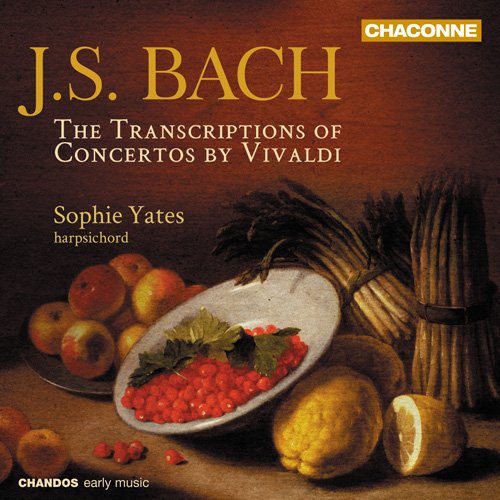Sophie Yates - Bach: Transcriptions of Concertos by Vivaldi (2013)

Artist: Sophie Yates
Title: Bach: Transcriptions of Concertos by Vivaldi
Year Of Release: 2013
Label: Chandos
Genre: Classical
Quality: FLAC (image + .cue, log, booklet)
Total Time: 76:26 min
Total Size: 508 MB
WebSite: Album Preview
Tracklist:Title: Bach: Transcriptions of Concertos by Vivaldi
Year Of Release: 2013
Label: Chandos
Genre: Classical
Quality: FLAC (image + .cue, log, booklet)
Total Time: 76:26 min
Total Size: 508 MB
WebSite: Album Preview
[1]-[3]Concerto in D major, BWV 972
after Concerto, L’estro armonico, Op. 3 No. 9, RV 230 (Amsterdam, 1711),
by Antonio Vivaldi (1678 – 1741)
[4]-[6]Concerto in G major, BWV 973
after Concerto a cinque stromenti, Op. 7 No. 8, RV 299 (Amsterdam, 1720)
by Antonio Vivaldi
[7]-[9]Concerto in D minor, BWV 974
after Oboe Concerto, from Concerti a cinque (Amsterdam, c. 1717),
by Alessandro Marcello (1669 – 1747)
[10]-[12]Concerto in G minor, BWV 975
after Concerto, La stravaganza, Op. 4 No. 6, RV 316 (Amsterdam, 1716),
by Antonio Vivaldi
[13]-[15]Concerto in C major, BWV 976
after Concerto, L’estro armonico, Op. 3 No. 12, RV 265 (Amsterdam, 1711),
by Antonio Vivaldi
[16]-[18]Concerto in F major, BWV 978
after Concerto, L’estro armonico, Op. 3 No. 3, RV 310 (Amsterdam, 1711),
by Antonio Vivaldi
[19]-[21]Concerto in G major, BWV 980
after Concerto, La stravaganza, Op. 4 No. 1, RV 381 (Amsterdam, 1716),
by Antonio Vivaldi
[22]-[25]Concerto in C minor, BWV 981
after Concerto a cinque, Op. 1 No. 2 (Venice, 1708)
by Benedetto Giacomo Marcello (1686 – 1739)
This recording brings together all the arrangements for harpsichord by Bach of instrumental concertos by his Italian contemporary Antonio Vivaldi, adding those of one concerto each by the brothers Alessandro and Benedetto Marcello. They are performed by Sophie Yates who has made a series of solo CDs for Chandos, many of which have won international awards. She has been described by Gramophone as ‘hugely talented’ and by BBC Music as playing ‘with exceptional poise’.
The concertos by Vivaldi are taken from three different sets: L’estro armonico, Op. 3, La stravaganza, Op. 4, and the set of twelve Concerti a cinque, Op. 7. These are all works which Vivaldi composed early in his career, when he was still making his reputation. For these concertos, Vivaldi chose a Dutch publisher, which crucially allowed the concertos to become available in Northern Europe. This in turn helped to increase the popularity of the concertos, not to mention the influence of Vivaldi’s style. In the words of The New Grove dictionary, L’estro armonico was ‘the most influential music publication of the first half of the eighteenth century’.
So why did Bach choose to tackle the difficult problem of conveying the quintessential Venetian violin sound on a keyboard instrument? One explanation could be that Bach transcribed these concertos for his own education, later adopting the new ideas in works such as the Concerto in the Italian Style for harpsichord. Or perhaps Bach simply enjoyed these works so much that he wanted to experiment with them. Yet another explanation is provided by the German musicologist Arnold Schering, who wrote: ‘we shall have to seek the purpose of these arrangements in practical music-making and be able to accept that within a short time the new concerto of the Italians became such a favourite that players wanted to be able to play the particularly popular concertos with their own two hands on clavichord or organ. Bach’s arrangements would then be considered to be what they really are: keyboard extractions, “for the soul’s refreshment of music-lovers”.’
The concertos by Vivaldi are taken from three different sets: L’estro armonico, Op. 3, La stravaganza, Op. 4, and the set of twelve Concerti a cinque, Op. 7. These are all works which Vivaldi composed early in his career, when he was still making his reputation. For these concertos, Vivaldi chose a Dutch publisher, which crucially allowed the concertos to become available in Northern Europe. This in turn helped to increase the popularity of the concertos, not to mention the influence of Vivaldi’s style. In the words of The New Grove dictionary, L’estro armonico was ‘the most influential music publication of the first half of the eighteenth century’.
So why did Bach choose to tackle the difficult problem of conveying the quintessential Venetian violin sound on a keyboard instrument? One explanation could be that Bach transcribed these concertos for his own education, later adopting the new ideas in works such as the Concerto in the Italian Style for harpsichord. Or perhaps Bach simply enjoyed these works so much that he wanted to experiment with them. Yet another explanation is provided by the German musicologist Arnold Schering, who wrote: ‘we shall have to seek the purpose of these arrangements in practical music-making and be able to accept that within a short time the new concerto of the Italians became such a favourite that players wanted to be able to play the particularly popular concertos with their own two hands on clavichord or organ. Bach’s arrangements would then be considered to be what they really are: keyboard extractions, “for the soul’s refreshment of music-lovers”.’

![Stille Grender, Eva Bjerga Haugen - Svart senker natten seg (2025) [Hi-Res] Stille Grender, Eva Bjerga Haugen - Svart senker natten seg (2025) [Hi-Res]](https://www.dibpic.com/uploads/posts/2025-12/1765550212_ktbxqyoaitggb_600.jpg)


![Cosmic Swing Orchestra - JUL (2025) [Hi-Res] Cosmic Swing Orchestra - JUL (2025) [Hi-Res]](https://www.dibpic.com/uploads/posts/2025-12/1765510492_cover.jpg)

![Mark Pringle - New Customers (2025) [Hi-Res] Mark Pringle - New Customers (2025) [Hi-Res]](https://www.dibpic.com/uploads/posts/2025-12/1765497171_fb7vtyplm5lta_600.jpg)

